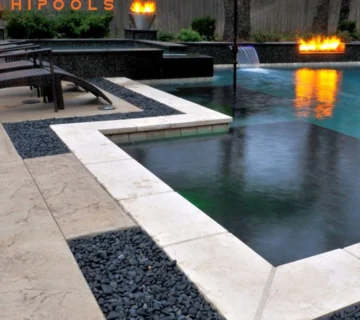Installing an above-ground pool can be an excellent choice for homeowners looking to enhance their outdoor space with a practical and cost-effective solution. Whether you’re interested in the refreshing benefits of a backyard pool or seeking a way to create a relaxing retreat at home, the process involves careful planning and understanding. From selecting the right filtration system and pool liner to preparing the ground and considering maintenance, there are key steps to ensure a smooth installation and long-term enjoyment. This guide will walk you through everything you need to know about above ground pool installations, compare them to in-ground pools, and provide helpful tips on poolside landscaping and safety. Let’s dive into how you can transform your backyard with a beautiful, functional pool.
Choosing the Right Location Above Ground Pool Installations
Selecting the ideal location for your above-ground pool is one of the most crucial steps in the installation process. A well-chosen spot not only ensures a safe and smooth installation but also enhances the longevity and functionality of your pool. Here are the key factors to consider when deciding where to place your pool.
1. Flat and Level Ground
The most important factor in choosing the location for your above-ground pool is ensuring the area is flat and free from slopes. Pools require a stable, level foundation to prevent any potential issues during installation and to avoid water unevenly distributing across the pool. A sloped area can create a situation where one side of the pool is higher than the other, leading to water pressure imbalances, leaks, and potential damage to the pool structure. Therefore, when you begin your search, always prioritize a flat, even area to guarantee a seamless setup and long-term use.
2. Distance from Trees and Structures
When selecting the right spot for your pool, make sure to position it a safe distance away from trees, power lines, and other structures. Trees may provide a beautiful aesthetic, but they also come with certain risks. Falling branches, leaves, and debris can quickly clog your pool’s filtration system, requiring more maintenance and cleaning. Additionally, tree roots can interfere with the ground preparation and potentially damage the pool’s liner. To avoid these issues, place your pool at least 10 to 15 feet away from large trees or structures. Also, ensure your pool is at a reasonable distance from power lines to avoid safety hazards and ensure the accessibility of pool equipment.
3. Consider the Soil and Ground Quality
The quality of the soil is another critical consideration when choosing your pool’s location. The soil should be compact and stable enough to support the weight of the pool once it’s filled with water. Loose, sandy, or uneven soil can lead to shifting or settling over time, which could compromise the pool’s structure. Additionally, sharp rocks, large stones, or debris present in the ground can puncture the pool liner, leading to leaks or tears. Before starting your installation, take the time to examine the soil carefully. If necessary, clear the area of any sharp objects or debris, and consider compacting the soil or using a layer of sand or a pool pad to create a smooth, sturdy base.
4. Access to Utilities and Space for Pool Equipment
Finally, make sure that your chosen location has adequate access to utilities, such as electrical connections for the pool pump and filtration system. A spot near a power outlet will make the installation process much more straightforward. Additionally, leave enough space around the pool for poolside equipment, like ladders, cleaning supplies, and storage for pool chemicals.
Click here for more information about The best equipment for your swimming pool.
By carefully selecting a location that is flat, clear of obstructions, and has solid, stable ground, you’ll ensure a hassle-free installation and years of enjoyment in your backyard pool.
Preparing the Ground for Your Above Ground Pool
Proper ground preparation is a critical step in ensuring the success and longevity of your above-ground pool. Taking the time to thoroughly prepare the ground will not only help with the installation but also contribute to the durability of the pool structure. Here’s how to effectively prepare the ground for your pool.
1. Level and Smooth the Ground Thoroughly
The first and most essential task in preparing the ground is ensuring that the area is completely level and smooth. Uneven ground can lead to imbalances in water distribution, causing stress on the pool walls and making it more likely to experience issues over time. To achieve this, use a shovel or rake to remove any bumps, rocks, or debris, and check the area with a level tool. It’s important to double-check that every part of the area is uniform and flat. A smooth, even surface is crucial not only for the pool’s structural integrity but also for ensuring that the water fills evenly, reducing the risk of leaks or water pressure problems.
2. Use Layers of Sand or Gravel for a Soft, Stable Base
Once the area is level, you’ll need to create a stable base for the pool. This is typically done using a layer of sand or gravel. Sand is the most commonly used material as it provides a soft, even surface that helps distribute the weight of the pool evenly. Spread a generous layer of sand (about 2-3 inches thick) across the ground and smooth it out using a rake. Gravel is another option, but it may be a bit less ideal for pools since it can cause the pool’s liner to shift or puncture. If you choose gravel, ensure it’s fine and compacted well to avoid creating uneven spots. The key is to create a solid and level foundation that will absorb the weight of the pool and prevent it from sinking or shifting over time.
3. Install a Protective Underlayment for Pool Floor Protection
To safeguard your pool’s floor and liner, it’s highly recommended to install a protective underlayment. This layer acts as a barrier against sharp objects, debris, or rocks that could damage the pool liner. Underlayments are typically made from durable materials like geotextile fabric or foam padding, providing an extra layer of protection and enhancing the comfort and durability of the pool. Once you’ve spread the sand or gravel, lay the underlayment across the area before setting up the pool. This simple step will help preserve the pool’s structure and ensure the liner remains intact throughout the seasons, reducing the risk of costly repairs or replacements.
Assembling Your Above Ground Pool
Proper assembly ensures your pool is stable, watertight, and efficient. Here’s a simplified guide to assembling your above-ground pool.
1. Assemble the Wall Panels and Frame
Start by carefully following the manufacturer’s instructions for assembling the wall panels and frame. Secure the panels in place, ensuring they are aligned and level. Use the provided fasteners to connect the components, making sure the structure is solid and properly aligned.
2. Install the Pool Liner
Unfold and carefully position the pool liner, smoothing out any wrinkles. Ensure the liner is evenly distributed and snug against the walls and floor. Avoid overstretching to prevent tears, and secure it properly to avoid leaks.
3. Connect the Filtration System and Water Pump
Place the filtration system and water pump near the pool. Follow the instructions to connect the hoses and ensure everything is secure. Check for leaks and test the system to ensure proper water circulation and filtration.
By following these steps, you’ll ensure a properly assembled, functional pool ready for use.
Filling the Pool & Testing the System
After assembling your pool, start by filling it with water. As the water level rises, check the circulation and filtration systems to ensure proper operation. Make sure the water flows through the system without any issues or leaks. Once filled, test and adjust the water chemistry—particularly the chlorine and pH levels—to maintain a safe and balanced swimming environment.
5. Maintenance & Safety Tips
To keep your pool in optimal condition, clean and filter the water regularly. This helps prevent debris buildup and ensures water clarity. Use a pool cover to minimize debris and reduce water evaporation when the pool is not in use. For added safety, install a pool fence or barrier, especially if you have children, to prevent unauthorized access and protect your loved ones from potential accidents.
How Much Does Above Ground Pool Installation Cost?
The cost of installing an above-ground pool can vary based on several factors, including the pool size, materials (such as steel, resin, or hybrid), and any additional services like landscaping or ground preparation. On average, professional installation costs typically range from $1,500 to $5,000 (or approximately 10 to 30 million Tomans in local currency). However, keep in mind that customizations or added features, such as premium filtration systems, pool decks, or fencing, can increase the overall cost. It’s essential to get a detailed estimate from a professional to understand the full scope of expenses based on your specific needs and preferences.
Cost Breakdown
| Factor | Cost Range | Details |
| Pool Kit | $800 – $5,000+ | Depends on size (12ft – 30ft) and material (steel, resin, hybrid). |
| Professional Installation | $1,500 – $3,500 | Includes ground prep, assembly, and system setup. |
| Additional Costs | $200 – $1,000+ | Covers landscaping, fencing, heaters, or premium liners. |
Conclusion
Installing an above-ground pool is an exciting way to enhance your backyard and create a relaxing space for family and friends. By carefully selecting the right location, preparing the ground properly, assembling the pool with precision, and performing regular maintenance, you can enjoy years of fun and relaxation. Remember, the key to a successful installation lies in attention to detail and proper planning. Whether you’re considering a simple setup or adding custom features, understanding the costs and steps involved will ensure a smooth and enjoyable experience.
For all your above-ground pool needs, Hi Poolss is here to provide expert guidance and top-quality products. Our team is dedicated to helping you find the perfect pool solution that fits your space, budget, and lifestyle. Visit us today to explore our pool options and get started on creating your ideal backyard oasis.
By following these guidelines, your above ground pool will become a safe and inviting oasis for your family! 🌊



No comment